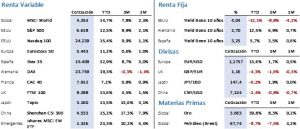Financial Markets 16/9/2025
The second week of September saw markets maintain their positive tone, with the world’s leading stock exchanges once again posting gains in their indices. As expected, the ECB kept interest rates unchanged and also revised its growth estimate for 2025 in the Eurozone upwards to +1.2% from the previous 0.9%. Similarly, its inflation forecast has been adjusted upwards to 2.1% from 2% for 2026 and 2027, and it now expects inflation levels of 1.9% and 1.8% respectively, very much in line with underlying data levels. The market has interpreted this data as meaning that the cycle of rate cuts may have come to an end, despite the fact that the ECB itself indicated that it expects interest rates to remain low for an extended period of time, but that they will react to changes in the evolution of key macroeconomic indicators, especially inflation. The S&P 500 closed at 6,584.29 points, up 1.59% from the previous week after hitting a new all-time high of 6,600.21 points, while the Nasdaq 100 did the same at 24,137.06 points, closing at 24,092.19, up 1.86%. Europe was not far behind, with the Euro Stoxx 50 rising 1.37% to 5,391.10 points and the Ibex 35 rising 3% to 15,303.90 points. Movements in fixed income markets were minor, especially after the significant adjustments of the previous week. The 10-year Treasury yield fell 3 basis points to 4.06%, pending the decision on interest rates in the United States. Remember that the Fed members are meeting on Tuesday and Wednesday and that the market is discounting a 25 basis point cut. In Europe, sovereign debt yields rose slightly following the ECB’s revisions of the main macroeconomic indicators, with the Bund ending the week at 2.71%, up 5 bps on the previous week, and the Bono at 3.28%, up 3 bps. In alternative markets, precious metals continued their seemingly endless upward trend. Gold rose 0.76% during the week, which may not seem like much, but it set a new all-time high of $3,714.75/oz. Although it ended Friday’s session at $3,681.25/oz, geopolitical uncertainty and falling interest rates in the United States continue to drive this movement. Oil, meanwhile, rose 2.12%, with Brent recovering some of the ground lost in previous weeks to close at $66.89/bbl, after OPEC+ decided to increase crude oil production by less than the market had estimated and Saudi Arabia had demanded. Macroeconomic data in Europe and the United States, while not spectacular, show the strength of both economies, which reduces the possibility of a recession and, therefore, a collapse in demand for crude oil. In terms of macroeconomic data, apart from the ECB’s decision, we highlight that last week both China’s exports and imports fell short of estimates, but as the impact on imports was greater, its trade balance increased more than the market had anticipated. In addition, the CPI returned to negative territory with an annualized figure of -0.4%, so there does not appear to be any reaction in domestic demand for now. In the United States, the CPI rose to 2.9% as expected, and core inflation remained stable at 3.1%, making it clear that the Fed has not yet been able to control price developments. Also on the negative side, data on consumer confidence expectations (55.4 vs. 58.2 previously) and inflation (3.9% vs. 3.4% previously over five years) from the University of Michigan were released. The most positive data was the upward revision to 3.1% of the Atlanta Fed’s GDP estimate for Q3 2025, which, if confirmed, could lead the Fed to raise its forecasts for 2025, currently at 1.4%. This week we will be watching out for the following publications: i) China, industrial production data and unemployment rate, ii) Europe, industrial production, ZEW investor confidence and CPI data, and iii) the United States, August retail sales, industrial production and, above all, the Fed meeting and its subsequent comments.
Quote of the day:
We leave you with the following quote from Lou Holtz, American writer and college coach: “It’s not the load that breaks you down, it’s the way you carry it.”
Summary of the performance of major financial assets (15/9/2025)

This report does not provide personalized financial advice. It has been prepared independently of the specific financial circumstances and objectives of the individuals who receive it.
This document has been prepared by Portocolom Agencia de Valores S.A. for the purpose of providing general information as of the date of issuance of the report and is subject to change without prior notice. Portocolom Agencia de Valores S.A. assumes no obligation to communicate such changes or to update the content of this document. Neither this document nor its content constitutes an offer, invitation, or solicitation to purchase or subscribe to securities or other instruments, or to make or cancel investments, nor may it serve as the basis for any contract, commitment, or decision of any kind.
The information included in this report has been obtained from public sources considered reliable, and although reasonable care has been taken to ensure that the information included in this document is neither uncertain nor ambiguous at the time of publication, we do not represent that it is accurate or complete and it should not be relied upon as such. Portocolom Agencia de Valores S.A. assumes no responsibility for any direct or indirect loss that may result from the use of the information provided in this report. Past performance of variables may not be a good indicator of their future outcomes.



